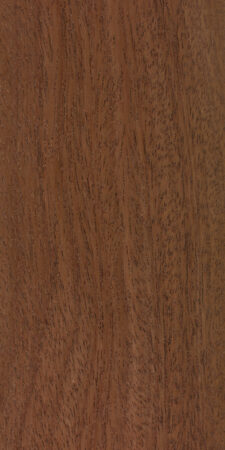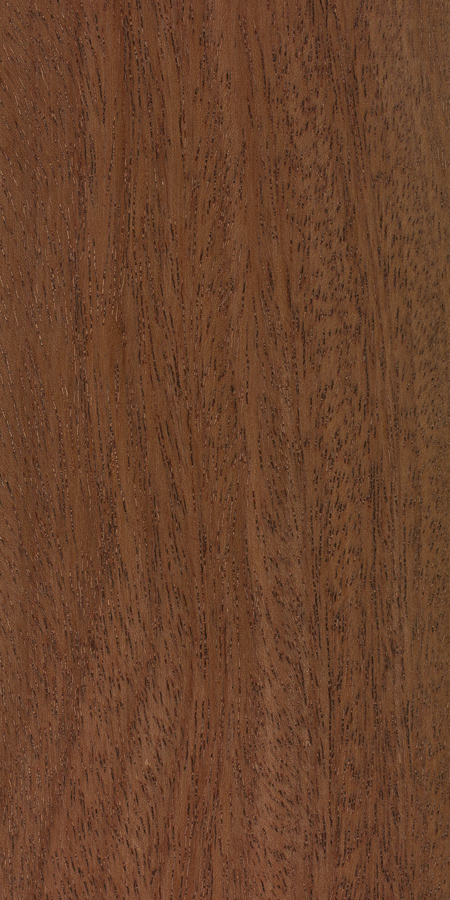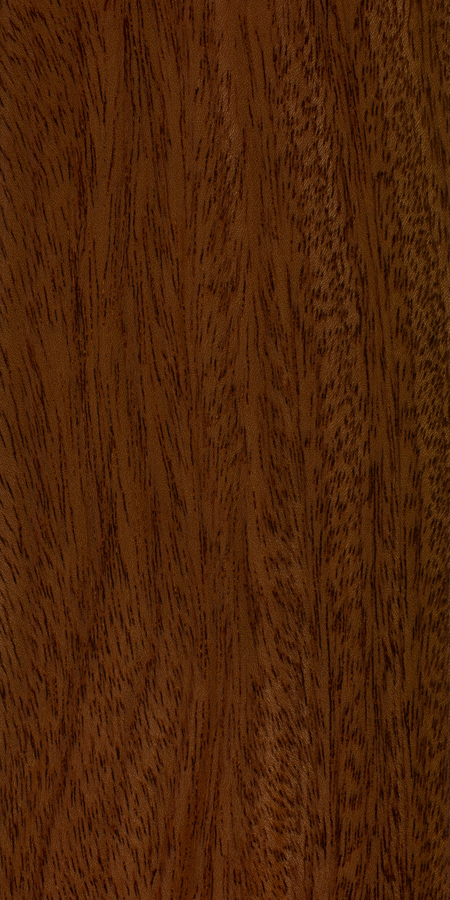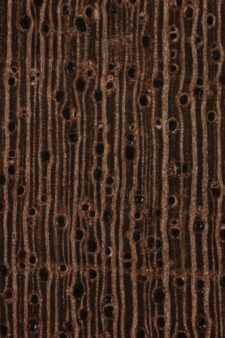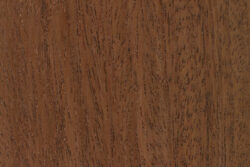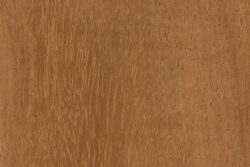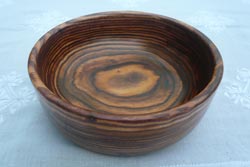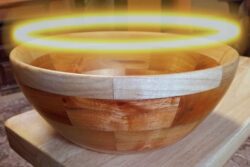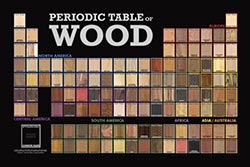Common Name(s): Dry zone mahogany, African mahogany, Senegal mahogany, acajou cailcedrat
Scientific Name: Khaya senegalensis, (A. grandifoliola is also occasionally included in this group; see notes below)
Distribution: Tropical West Africa
Tree Size: 65-100 ft (20-30 m) tall,
2-3 ft (.6-1 m) trunk diameter
Average Dried Weight: 48.1 lbs/ft3 (770 kg/m3)
Specific Gravity (Basic, 12% MC): .63, .77
Janka Hardness: 1,350 lbf (6,010 N)
Modulus of Rupture: 13,460 lbf/in2 (92.8 MPa)
Elastic Modulus: 1,615,000 lbf/in2 (11.13 GPa)
Crushing Strength: 8,010 lbf/in2 (55.2 MPa)
Shrinkage: Radial: 4.7%, Tangential: 6.8%,
Volumetric: 11.6%, T/R Ratio: 1.5
Color/Appearance: Heartwood ranges from medium to dark reddish brown, sometimes with darker streaks. Overall color tends to be slightly darker than other Khaya species. Colors darken with age. Sapwood is lighter-colored, and not always sharply demarcated from heartwood. Quartersawn surfaces exhibit a ribbon-stripe appearance.
Grain/Texture: Grain is usually interlocked, though sometimes straight. Medium to coarse texture with good natural luster and a high degree of chatoyancy.
Rot Resistance: Rated as moderately durable to durable; good termite resistance, though other Khaya species can be intermixed and have poorer insect/borer resistance. Sapwood is also susceptible to borers.
Workability: Generally easy to work, though tearout can be a problem on quartersawn surfaces due to the interlocked grain. Moderate blunting effect on cutters. May stain and react with iron-based fasteners in damp conditions. Glues, turns, and finishes well.
Odor: No characteristic odor.
Allergies/Toxicity: Although severe reactions are quite uncommon, African mahogany in the Khaya genus has been reported as a sensitizer. Usually most common reactions simply include eye and skin irritation. See the articles Wood Allergies and Toxicity and Wood Dust Safety for more information.
Pricing/Availability: Dry zone mahogany in particular isn’t as readily available as the other species exported and sold as African mahogany. Pieces may be incidentally mixed with the other commercial Khaya species for export, but most K. senegalensis logs are processed and used locally.
Sustainability: Dry zone mahogany is listed in CITES Appendix II under the genus-wide restriction of all Khaya species from Africa. Additionally, all the primary Khaya species of African mahogany are on the IUCN Red List. They are each listed as vulnerable due to a population reduction of over 20% in the past three generations, caused by a decline in its natural range, and exploitation.
Common Uses: Veneer, cabinetry, furniture, flooring, boatbuilding, interior trim, turned objects, and other small specialty wood items.
Comments: There are currently five accepted Khaya species, four of which are harvested and sold as African mahogany. The fifth species, K. madagascariensis, is native to Comoros and northern Madagascar and yields mahogany-like wood, but isn’t commonly exported.
Of the four commercial species, there is considerable variation in density and heartwood color. The heaviest species, K. senegalensis, is represented here on this page. The two lightest species, K. ivorensis and K. anthotheca, are most commonly harvested and sold as African mahogany, and have been given their own separate page. Lastly, K. grandifoliola occupies a middle-ground in terms of density, sometimes being mixed and sold with the latter two lighter species, and sometimes grouped with the heavier K. senegalensis.
According to Plant Resources of Tropical Africa,[1]Louppe, D., Oteng-Amoako, A. A., & Brink, M. (2008). Plant Resources of Tropical Africa 7 (1). Timbers 1. PROTA foundation. the average specific gravity of each of the commercial species at 12% moisture are as follows:
- K. ivorensis—0.52
- K. anthotheca—0.58
- K. grandifoliola—0.69
- K. senegalensis—0.76
Botanically, Khaya is a part of the Meliaceae family, which not only includes mahoganies, but also sapele (Entandrophragma cylindricum), Spanish cedar (Cedrela odorata), and a host of other commercial species. Considered to be a valid substitute for Honduran mahogany (Swietenia macrophylla), otherwise known as ‘genuine mahogany’—though the African species sometimes lack the deeper reddish brown color and durability that’s common for true mahogany in the Swietenia genus.
Images: Drag the slider up/down to toggle between raw and finished wood.
Identification: See the article on Hardwood Anatomy for definitions of endgrain features.
Porosity: diffuse porous
Arrangement: solitary and radial multiples
Vessels: large to very large, very few; dark brown to nearly black deposits occasionally present
Parenchyma: vasicentric, and occasionally banded (marginal)—though marginal parenchyma isn’t typical for Khaya species
Rays: medium to wide; normal spacing
Lookalikes/Substitutes: Very commonly confused with the New World mahoganies in the Swietenia genus. However, Khaya species will very frequently lack maringal parenchyma bands. For more information, see the article Mahogany Mixups.
Notes: Although there is a subtle gradation in density between the various Khaya species, they can’t be reliably separated on the basis of anatomy.
Related Content:

